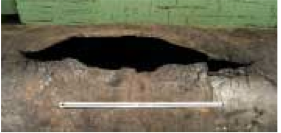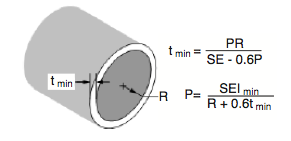Deadly Corrosion Failures
A few years ago, TWI investigated a corrosion failure in a 30 inch crude oil pipeline (Fig.1) that regrettably led to an explosion and fire, and the death of several operating personnel. The pipeline was designed to ASME B31.4 and the investigation found that corrosion resulted from the break-down of the external coating. The exposed area of pipe was too large for the cathodic protection system.

Pitting corrosion initiated at several locations that coalesced over a large area to cause failure by rupture. The lost production from this failure was 300,000 bbl/d. The corrosion in this pipeline was not detected before failure. However, if corrosion is found in service pressure equipment, there are safe guidelines available for inspection engineers to assess the fitness- for-service (FFS) of corrosion damage.
FFS procedures have been developing since the late 1960s, and were initially, simply reverse design rules. For example, the remaining wall thickness at the bottom of a locally thinned area (LTA) was input into the Code design pressure-thickness equation to calculate the maximum allowable working pressure (MAWP), Fig.2.

Several FFS approaches for assessing corrosion LTAs are available, Table 1. This table excludes proprietary tools incorporated in assessment software, eg. PCORRC (Battelle), RSTRENG (PRCI), FEA Flaw (SRT), etc. With the proliferation of procedures and tools, the choice of FFS assessment procedure is becoming somewhat more difficult. The most widely used FFS procedures (even though they may not give the same results), are the recommended practice for assessing fitness- for-service published by the American Petroleum Institute in API RP 579 (second edition due in 2006), and the guidance for the assessment of flaws in structures published by the British Standards Institute in BS 7910 (the successor to PD 6493, revised in 2005).

Why is the Use of FFS Limited?
While users and regulators across industry now increasingly accept flaws and damage in equipment assessed as fit-for-service, the differences between the available procedures and the implied safety margins are not widely known. There are difficulties in obtaining the data and differences in the engineers’ skills and knowledge required to make good assessments, and even disagreements amongst “the experts” about the best procedures. As a result, the benefits of FFS assessment are not (yet) as widespread as might have been expected from recent publicity.
In 2001, TWI carried out a worldwide industry survey on the use of FFS procedures. All sectors of industry were represented, and many were major users of pressure equipment mostly offshore oil and gas, petrochemicals, refining and fossil power companies. Respondents to the survey gave many reasons for undertaking FFS assessment, in order of importance, as follows:
















Comments and Discussion
There are no comments yet.
Add a Comment
Please log in or register to participate in comments and discussions.